
Food is an essential part of a country’s culture and is part of the experience of discovering a new place. In Iran, you won’t be running out of options when it comes to food, and snacks in particular.
Whether you’re more into sweets or salty treats, you’ll find a large variety of Persian snacks to enjoy all along your trips. To get you ready, here is an introduction to the yummiest popular treats in Iran.
Sweet Persian Snacks
Let’s start our culinary exploration of Persian delicacies with the sweet ones. While Iranians aren’t much into desserts and not as fan as Europeans of cakes, they do have a lot of sweets which are perfect to accompany a cup of tea. As delicious as they are, they’re also pretty caloric and sugar-filled, so watch out for the excesses!
Contents
1. Gaz: A Persian Delight
Gaz is a beloved Persian sweet made with rose water, pistachios, and sugar. It is a soft, chewy nougat that is both delicate and flavorful. Gaz is often served as a dessert or snack, and it is also used in other dishes, such as ice cream and pastries.
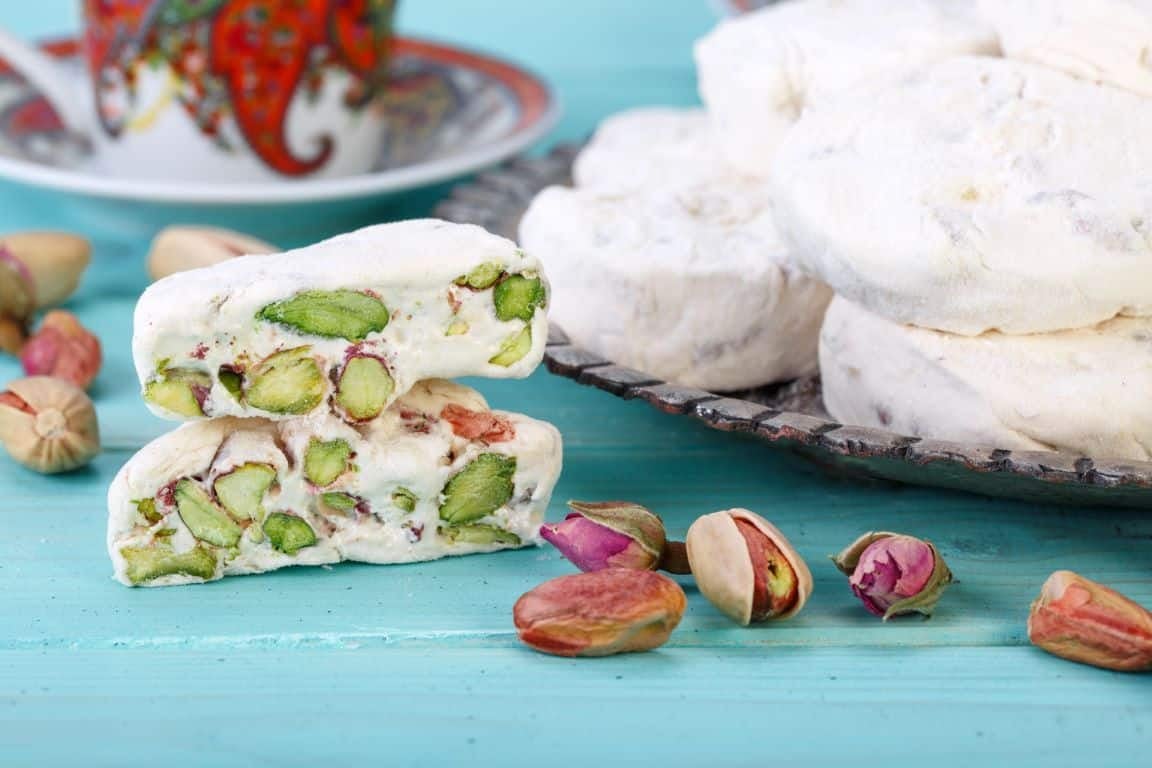
There are two main types of Gaz: Isfahan Gaz and Kerman Gaz. Isfahan Gaz is made with rose water and pistachios, while Kerman Gaz is made with saffron and almonds. Both types of Gaz are delicious, but they have slightly different flavors. Isfahan Gaz is known for its delicate rose flavor, while Kerman Gaz has a more robust saffron flavor.
Gaz is a symbol of Persian culinary mastery. It is a perfect example of how Persian chefs can take simple ingredients and create something truly special. Gaz is also a reflection of Iran’s rich history and culture. The rose water used in Gaz is a traditional ingredient in Persian cuisine, and the pistachios are a symbol of Iran’s fertile lands.
If you are looking for a truly unique and delicious sweet, I highly recommend trying Gaz. It is a treat that you will not soon forget.
Ingredients for Gaz:
- Olive oil
- Chicken legs (cut up)
- White onion (thinly sliced)
- Walnuts (toasted and finely ground in a food processor)
- Salt
- Pomegranate juice
- Cardamom (optional)
- Sugar (optional)

2. Sohan: A Sweet and Brittle Delight
Sohan, a treasured Persian delight, combines wheat flour, sugar, saffron, cardamom, and rose water, crafting a unique brittle toffee. Its texture is a delightful juxtaposition of crunch and chew, accompanied by a subtle floral note.
Originating in Qom, Iran, during the Qajar dynasty, Sohan transcends a simple dessert, serving as both a popular snack and a versatile ingredient in ice cream and pastries. Often exchanged as a thoughtful gift or enjoyed during religious festivities, it embodies the essence of Persian culinary culture. If you seek a sweet with a twist, indulge in the captivating flavors and history of Sohan.
Ingredients for Sohan:
- Unsalted butter
- Granulated sugar
- Rosewater (adjust to taste)
- Almonds, coarsely chopped
- Pistachios, coarsely chopped
- Flour
- Ground saffron (optional, for color and flavor)

3. Sweet Halva
Halva, a luscious sweet paste with a texture akin to jelly, finds itself prominently embraced in India and Arab countries today, although its roots trace back to Persia. Originating from the heart of Persia, Halva has established a global presence.
A multitude of tempting Halva flavors abound in Iran, with each offering a unique taste sensation. It’s a delightful pairing with coffee, serving as a perfect complement to its rich and aromatic notes. As a treat that transcends borders, Halva’s evolution from its Persian origins reflects its enduring appeal, appreciated by diverse cultures as a delectable indulgence.
Ingredients for Halva:
- Semolina (sooji/rava)
- Ghee (clarified butter)
- Sugar
- Water
- Chopped nuts (almonds, cashews, or pistachios)
- Ground cardamom
- Saffron strands (optional)

4. Irresistible Koloocheh Treats
“Koloocheh” is a generic word that designates cookies. Each region has its own koloocheh in Iran, and some are most famous than others: The Koloocheh Fumani, from the city of Fuman (Gilan) is the superstar of these cookies. It is made with cinnamon and is best appreciated warm. Kolompeh Kermani are quite similar to Koloocheh, as it is a soft and dry pastry filled with dates and walnuts that is also very popular.
Ingredients for Koloocheh
- All-purpose flour
- Unsalted butter, softened
- Vegetable oil
- Sugar
- Yogurt
- Baking powder
- Baking soda
- Salt
- Vanilla extract
- Dates, pitted and chopped
- Chopped walnuts or pistachios (optional)
- Ground cinnamon

5. Delicious Baghlava or Bakhlava Bliss
Although Turkey is renowned for its Bakhlava, this delectable treat also graces the culinary landscape of Iran, notably in the northwest region, with Tabriz as a prominent hub for its production. Here, it goes by the name “Baghlava Reshtei,” signifying its unique twist. These sumptuous delights, characterized by their intense sweetness, have become one of Tabriz’s specialties, showcasing the city’s culinary finesse.
While Turkey holds the limelight, Iran’s Baghlava Reshtei represents a lesser-known gem, a testament to the diversity of Bakhlava variations found across cultures. The northwest’s mastery in crafting these delectable creations adds to Iran’s rich culinary tapestry. For those with a taste for sweet indulgence, Baghlava Reshtei presents a tantalizing opportunity to savor a unique Iranian interpretation of this iconic dessert.
Ingredients for Baklava (Baghlava):
- Phyllo dough
- Unsalted butter, melted
- Walnuts, finely chopped
- Pistachios, finely chopped
- Sugar
- Ground cinnamon
- Ground cloves
- Lemon juice (for the syrup)
- Honey (for the syrup)
- Water (for the syrup)

6. Baslogh: Unique Sweets
Baslogh, a beloved delicacy, enjoys widespread popularity during Nowruz, the Persian New Year, with its roots tracing back to the province of East Azerbaijan in Iran. This soft, tantalizing sweet is crafted from a delectable blend of sugar, fragrant rose water, and gelatin, creating a delicate texture that melts in the mouth.
Traditionally adorned with the rich nuttiness of walnuts and the delightful hint of coconut powder, Baslogh showcases the artistry and ingenuity of Iranian confectionery. Its presence during Nowruz festivities highlights its significance as a symbol of new beginnings, adding sweetness to the celebratory atmosphere of the holiday.
East Azerbaijan’s Baslogh exemplifies the essence of Nowruz, embodying the joy and hope that this special occasion brings to households across Iran. This treat, both culturally significant and exceptionally delicious, invites everyone to join in the festivities and indulge in the rich flavors of Iranian traditions.
Ingredients for Baslogh (Persian Sweet):
- Walnut kernels
- Gelatin powder
- Starch
- Water
- Liquid glucose (optional)
- Sugar
- Vanilla
- Cardamom powder
- Cold water
- Rose water
- Butter
- Coconut powder (as needed)

7. Shir Berenj and Shole Zard
Shir Berenj and Shole Zard, both cherished rice puddings, hold a place of honor, especially during the holy month of Ramadan. These delectable treats are comforting and rich in tradition, providing nourishment to those observing the fasting period.
Shir Berenj, a creamy delight, combines the goodness of milk and rice with the fragrant essence of rosewater and the warmth of cinnamon. This classic blend creates a harmonious balance of flavors, a soothing choice to break the fast.
Ingredients for Shir Berenj
- Rice (typically a fragrant variety like Basmati)
- Milk
- Sugar
- Rosewater or orange blossom water (optional, for flavor)
- Saffron (optional, for color and flavor)
- Ground cardamom
- Ground cinnamon
- Slivered almonds or chopped pistachios (for garnish)

8. Shole Zard
Shole Zard, on the other hand, boasts an additional touch of luxury with the inclusion of saffron and butter. Although it lacks cardamom, it doesn’t lack in richness or appeal. Its golden hue, courtesy of saffron, enhances its visual allure, making it an inviting dish for Iftar, the meal that breaks the fast.
As these rice puddings grace the tables of families and friends during Ramadan, they offer more than just culinary delight. They embody the spirit of togetherness, tradition, and the nourishment of body and soul during this sacred time, symbolizing the values and warmth of the Ramadan observance.
Ingredients for Shole Zard
- Rice
- Water
- Sugar
- Saffron threads
- Rosewater (optional, for flavor)
- Ground cinnamon
- Cardamom pods (optional, for flavor)
- Slivered almonds or chopped pistachios (for garnish)

9. Bamieh and Zoolbia Delicacies
Bamieh and Zoolbia, the twin stars of Ramadan‘s indulgent array, are exceptional deep-fried delights, akin to the beloved churros. Exclusively gracing tables during this holy month, these treats bring a burst of sweetness to the fasting period.
Bamieh, with its enticing saffron and rose water infusion, captures the essence of Persian flavors. These delectable morsels, once fried to golden perfection, become the perfect canvas for the syrup’s sweet embrace.
Zoolbia, a kindred spirit to Bamieh, boasts the same saffron and rose water allure, tantalizing the taste buds with their unique blend. The deep-fried texture, when combined with a generous drizzle of honey or syrup, creates a heavenly experience that sweetens the spirit of Ramadan gatherings.
Both treats symbolize the unity and togetherness of Ramadan, offering not only a delicious respite from the day’s fast but also a shared joy during the iftar, when families and friends come together to break bread and enjoy these exquisite, saffron-kissed confections.
Ingredients for Bamieh
- Fresh okra pods
- Sugar
- Water
- Rosewater (optional, for flavor)
- Lemon juice (for acidity and balance)
- Cornstarch (to thicken the syrup)
- Ground cinnamon (optional, for flavor)
Ingredients for Zoolbia
- Wheat starch
- Yogurt
- White flour
- Baking powder
- Thick brewed saffron
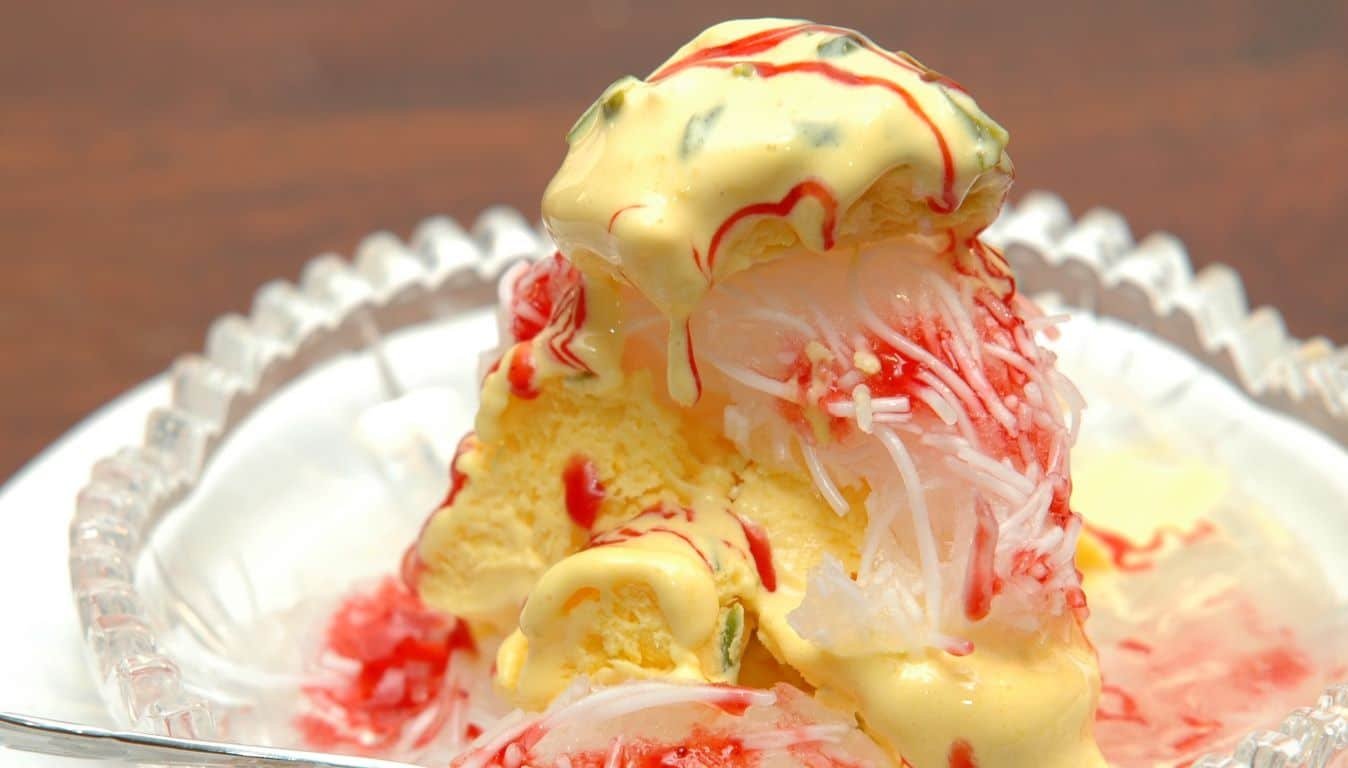
10. Faloodeh Bastani
One can’t go to Iran without trying “bastani”. Bastani is the word for ice cream, and the most popular of all is saffron ice cream. The texture is a bit different and thicker than other ice creams and it has pistachio in it. Another refreshing treat is Faloodeh, made of thin frozen noodles that are served in a syrup of sugar and rosewater. The best Faloodeh are usually from Shiraz and Yazd.
Ingredients for Faloodeh Bastani
- Cornstarch or rice flour
- Rosewater
- Sugar
- Water
- Vermicelli noodles (Faloodeh noodles)
- Vanilla ice cream (Bastani)

11. Nature’s Sweet Dates
Amateurs of date fruits (“khorma” in Persian) will be in paradise in Iran, where you can find many varieties everywhere. The most populars are Mozafati dates from Bam, which are generous fresh dates, as well as Rotab. But it’s also very common to eat dried and semi-dried dates. In the south of Iran, dates are usually served with Tahini. As it’s a very healthy snacks, make sure to have them as much as you can!
Iran’s Sweet Date Varieties
There are several popular varieties of dates cultivated in Iran, each with its own unique flavor, texture, and appearance. Here are some of the most famous Iranian date varieties:
- Mazafati (Rotab): Probably the most famous Iranian date, Mazafati dates are soft, dark brown, and have a sweet caramel-like taste. They are usually grown in the southern regions of Iran, particularly in the provinces of Kerman and Hormozgan.
- Piarom (Maryami): Piarom dates are often called “chocolate dates” because of their dark color and rich taste. They are grown in the Hormozgan province and are prized for their chewy texture and sweetness.
- Zahedi (Zahidi): Zahedi dates are medium-sized with a golden-yellow color and a slightly drier texture compared to other varieties. They are often used for making date-related products such as date sugar and syrup.
- Kabkab: Kabkab dates are known for their large size, softness, and rich taste. They are grown in the Bushehr and Fars provinces.
- Dayri: Dayri dates are typically smaller and oval-shaped with a dark brown to black color. They have a unique taste and are grown in the Bushehr and Fars provinces.
- Sayer: Sayer dates are elongated and often semi-dry with a reddish-brown color. They are grown in several provinces including Khorasan, Khuzestan, and Bushehr.
- Shahani: Shahani dates are known for their elongated shape and sweet taste. They are usually grown in the Sistan and Baluchestan province.
- Khashei: Khashei dates are medium-sized and have a sweet and pleasant taste. They are primarily grown in the Khuzestan province.
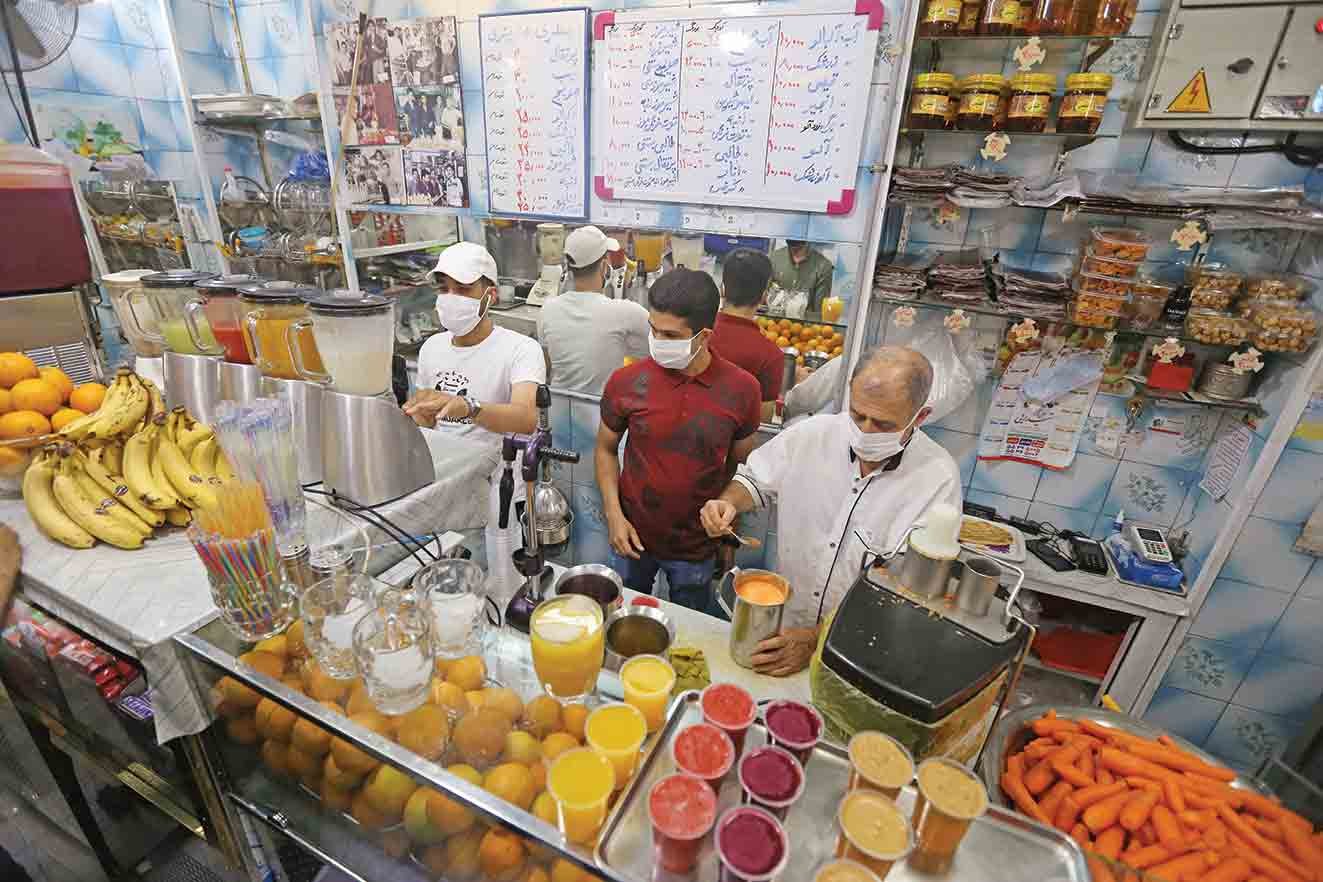
12. Fresh Fruit Juices
While it’s not a speciality from Iran, it’s interesting to note that you will find fresh fruit juices of all kinds at every corner of the streets in Iran, and for a low price. Make sure to have pomegranate juice if you travel during autumn or winter and mango juice if you’re visiting Iran near summertime.
Top 10 fresh fruit juices commonly consumed in Iran
- Pomegranate juice (Persian: “Ab-e Anar”) – a favorite for its rich flavor and health benefits.
- Orange juice (Persian: “Ab-e Porteghal”) – a classic citrus choice.
- Carrot juice (Persian: “Ab-e Havij”) – often combined with other fruits for a nutritious blend.
- Sour cherry juice (Persian: “Ab-e Albaloo”) – known for its tartness and refreshing taste.
- Apple juice (Persian: “Ab-e Sib”) – a widely enjoyed fruit juice.
- Peach juice (Persian: “Ab-e Holoo”) – popular during the peach season.
- Lemonade (Persian: “Ab-e Limoo”) – made from fresh lemons and typically sweetened.
- Watermelon juice (Persian: “Ab-e Hendevaneh”) – a cooling and hydrating option in hot weather.
- Grape juice (Persian: “Ab-e Angoor”) – particularly enjoyed during grape season.
- Apricot juice (Persian: “Ab-e Zardaloo”) – made from ripe apricots and loved for its natural sweetness.
Salty Persian Snacks
You’re more into salty snacks or you’re looking for a street-food alternative for a meal? No worries, Iran also has plenty of options for you, and here are some of our favorites:

13. Lavashak (Fruit Leather)
This one is actually a sweet and sour option, which fits in no category but is at the same time, the most emblematic Persian treat! Lavashak is sometimes translated to “Persian Fruit Leather” or “Persian Fruit Roll”. It’s a thin extract of fruits that is then dried. It can be made of all kinds of fruits, and the most popular are plum, apricot, pomegranate or barberry. You’ll find many sellers of homemade lavashak on the way to Darband and Darakeh mountains.
Ingredients for Lavashak (Persian Fruit Leather):
- Fresh ripe fruit (commonly used fruits include plums, apricots, grapes, cherries, and pomegranates)
- Sugar (optional, for sweetening)
- Lemon juice (optional, for acidity and flavor)
The process of making Lavashak involves pureeing the fruit, cooking it down into a thick paste, and then drying it to create a chewy, portable snack. It’s a popular treat in many Middle Eastern countries, including Iran.
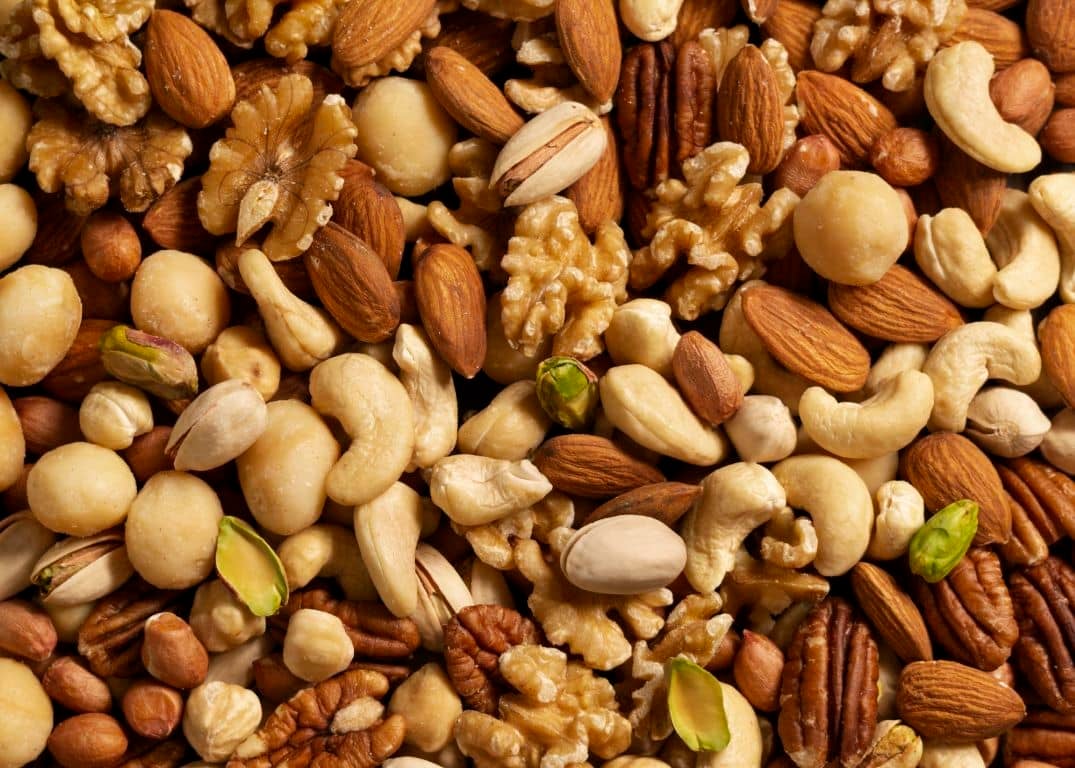
Nuts
Indeed, “ajil,” the beloved assortment of nuts, is an integral part of Iranian hospitality and snacking culture. In every Iranian household, you’ll discover a bowl brimming with these wholesome treats. Offering a perfect blend of flavors and textures, ajil is a versatile and nutritious snack, often paired with tea and various sweets when entertaining guests.
The medley typically combines a delightful array of tastes, featuring the rich crunch of almonds, chickpeas, hazelnuts, cashews, and pistachios, alongside the earthy goodness of walnuts and the subtle sweetness of sunflower seeds, dry figs, and raisins.
This customary offering reflects the warm Iranian tradition of welcoming visitors with a spread of delectable treats. Ajil embodies the culture of sharing, creating an inviting atmosphere and fostering a sense of connection over these delightful, healthful morsels. As an essential part of Iranian cuisine and hospitality, ajil paints a vivid picture of the country’s appreciation for flavors, traditions, and heartfelt gestures.
Iranian Popular Nuts
- Pistachios
- Almonds
- Walnuts
- Hazelnuts
- Cashews
- Pecans
- Dried figs (sometimes considered a nut in culinary contexts)
- Pine nuts
- Barberries (not a traditional nut but commonly used in Iranian cuisine)
- Sunflower seeds (often consumed as a snack)
- Pumpkin seeds (commonly eaten as a snack or in traditional dishes)
- Apricot kernels
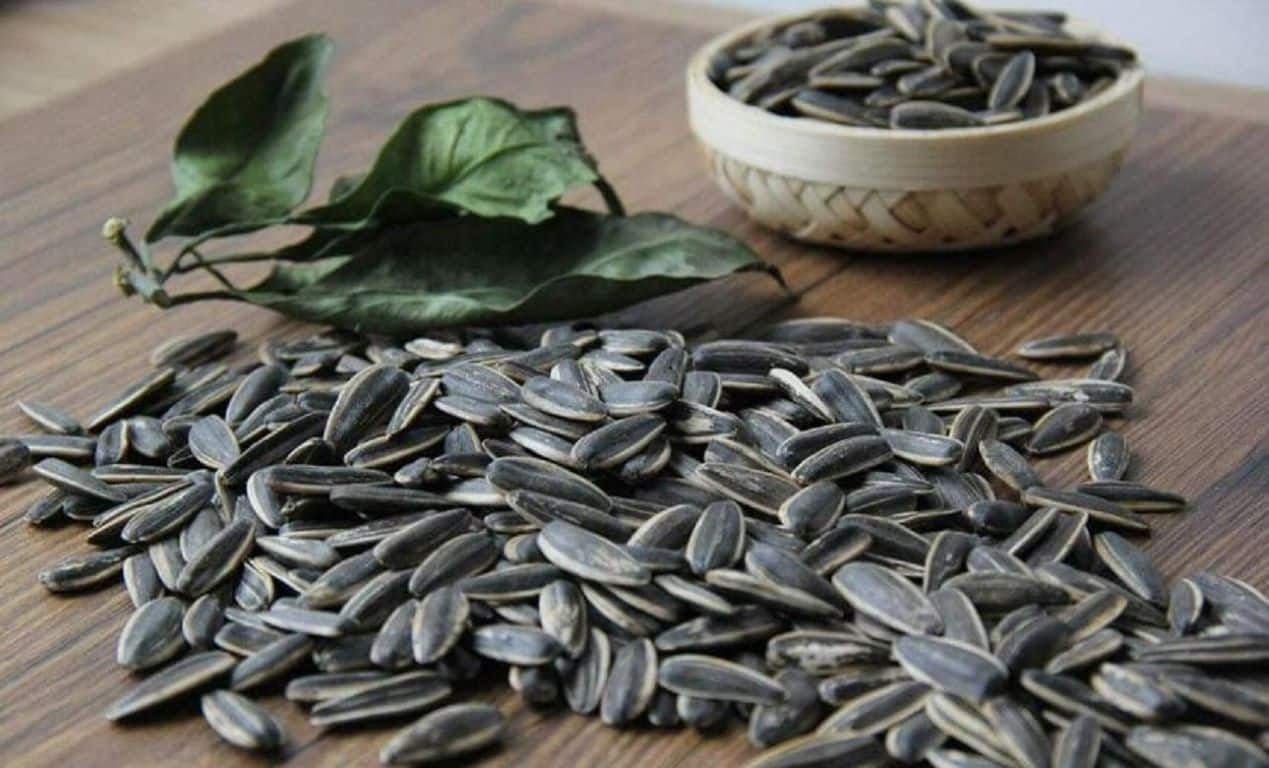
14. Tokhmeh
If eating seeds was elevated to an Olympic Sport, Persians would for sure win the competition! Iranians love to eat these seeds, most commonly sunflower, but also pumpkin or melon, while sitting with friends, watching television, or even driving.
Tokhmeh Seeds in Iran
Here’s a list of popular seeds used in Iranian cuisine and culture:
- Pumpkin Seeds (Kado Tokhmeh): Roasted pumpkin seeds, known as “Kado Tokhmeh,” are a favorite snack in Iran. They can also be used in various dishes or ground into a paste.
- Sunflower Seeds (Tokhmeh Aftabgardan): Roasted sunflower seeds are enjoyed as a snack, especially during gatherings and social occasions.
- Watermelon Seeds (Hendevaneh Tokhmeh): Roasted watermelon seeds, often referred to as “Japoni or Jabani Tokhmeh,” are a popular snack in Iran.
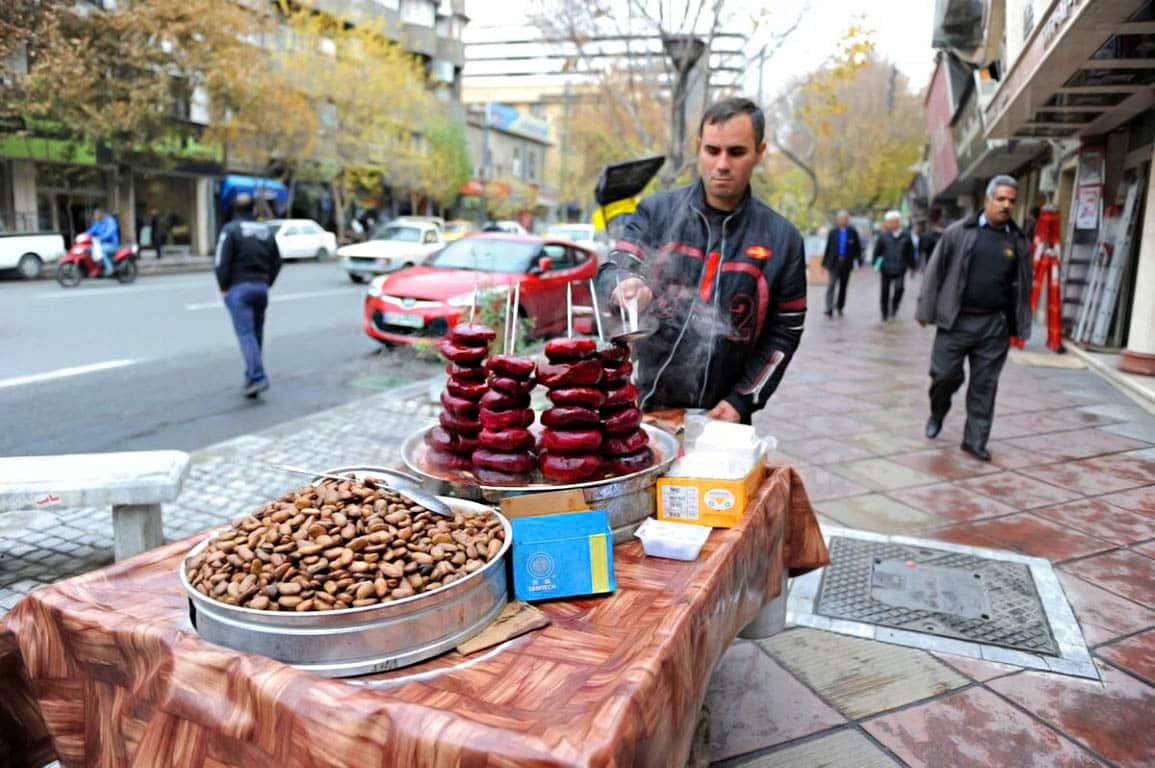
15. Balal, Laboo and Bagali
Roasted corn, known as “balal” in Persian, holds a special place as a beloved street snack in Iran, particularly during the chilly months. This simple yet delightful treat features corn on the cob, expertly roasted to perfection, imparting a comforting warmth and a smoky, rustic flavor.
In addition to balal, two other popular street snacks enrich the winter culinary experience. “Laboo,” or beetroot, offers a colorful and nutritious option. Its earthy, sweet taste makes it a delightful and vibrant choice for those seeking a healthy, hearty snack to ward off the cold.
“Bagali,” the cooked fava beans, completes this trio of winter delights. This protein-packed option brings a wholesome and filling aspect to the street food scene. Served warm, these tender beans offer a satisfying texture and a mild, comforting flavor, making them a go-to snack for locals seeking nourishment during the colder months.
These winter street snacks not only warm the body but also warm the heart, creating a sense of coziness and connection as people gather to enjoy these simple yet flavorful treats on the bustling streets of Iran.

16. Kashk
Kashk, a versatile dairy product, resides in a delightful culinary space between cheese and yogurt. Its creation begins with straining yogurt or sour milk, followed by a drying process, resulting in a unique texture and flavor profile. This delicacy serves as a flexible addition to the kitchen, offering both standalone enjoyment as a snack and enhancing various dishes.
Eaten on its own, Kashk delights with its tangy, slightly sour taste and distinctive consistency, inviting you to savor its essence. However, its true magic unfolds when it’s introduced into recipes. Kashk’s creamy texture and characteristic flavor can transform a dish, lending a rich, complex undertone that adds depth to stews, soups, and sauces.

17. Ash Reshteh: Wholesome Soup
Ash Reshteh, the crowning jewel among the many varieties of Ash in Iran, stands as an iconic and cherished dish. This hearty and flavorful thick soup showcases a perfect harmony of ingredients, making it a favorite among Iranians.
At its core, Ash Reshteh combines the heartiness of thick noodles with a medley of vegetables, aromatic herbs, and nourishing beans. The marriage of flavors and textures creates a comforting and satisfying experience for the palate.
Ingredients for Ash Reshteh
- Reshteh (Persian noodles)
- Kidney beans (or chickpeas)
- Green lentils
- Herbs (spinach, parsley, cilantro, and green onions)
- Garlic
- Onions
- Oil (vegetable or olive oil)
- Kashk (whey or whey substitute)
- Salt and pepper
- Turmeric (for color and flavor)
- Mint (for garnish, optional)
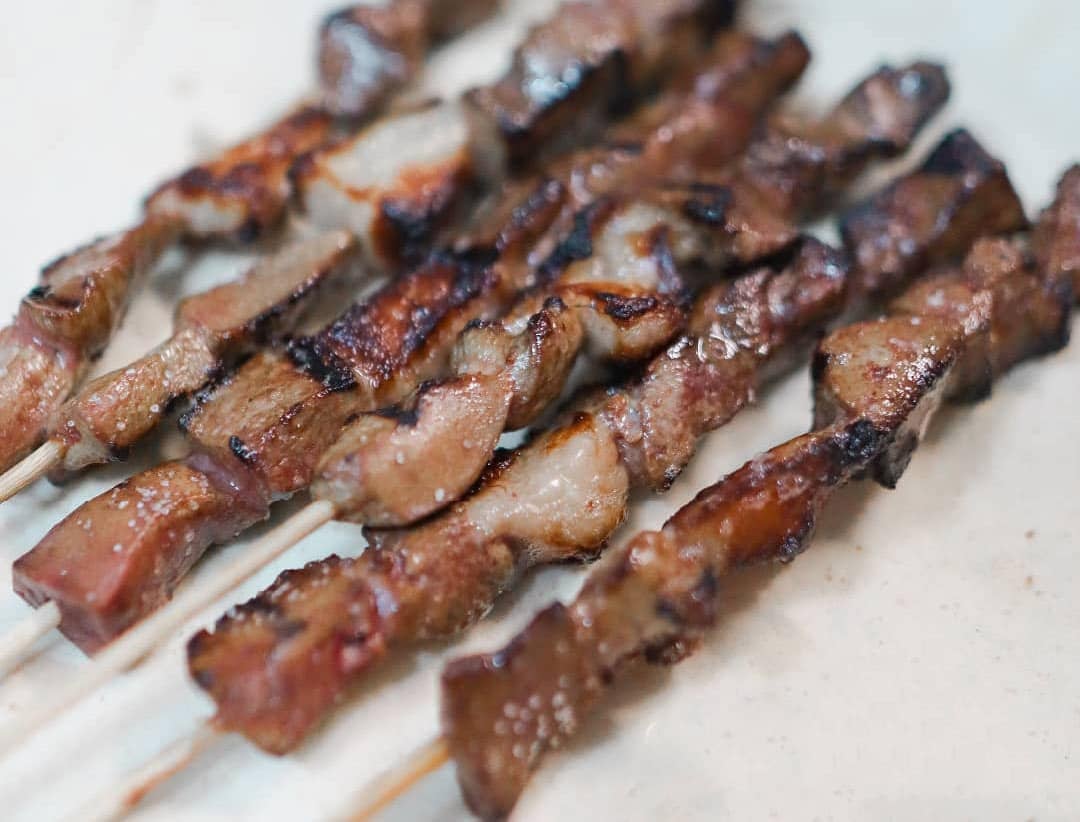
18. Jigar
Grilled liver, locally known as “jigar or jegar” is a popular and accessible street food in Iran, reflecting the nation’s vibrant culinary scene. Numerous establishments specialize in this quick and flavorful dish, making it convenient for locals and visitors to enjoy a satisfying meal on the go.
The succulent liver pieces, typically sourced from lamb, are skillfully grilled to perfection, resulting in tender morsels bursting with robust flavors. What makes this experience even more enticing is the option to accompany the jigar with heart or kidney kebabs, creating a hearty and varied feast.
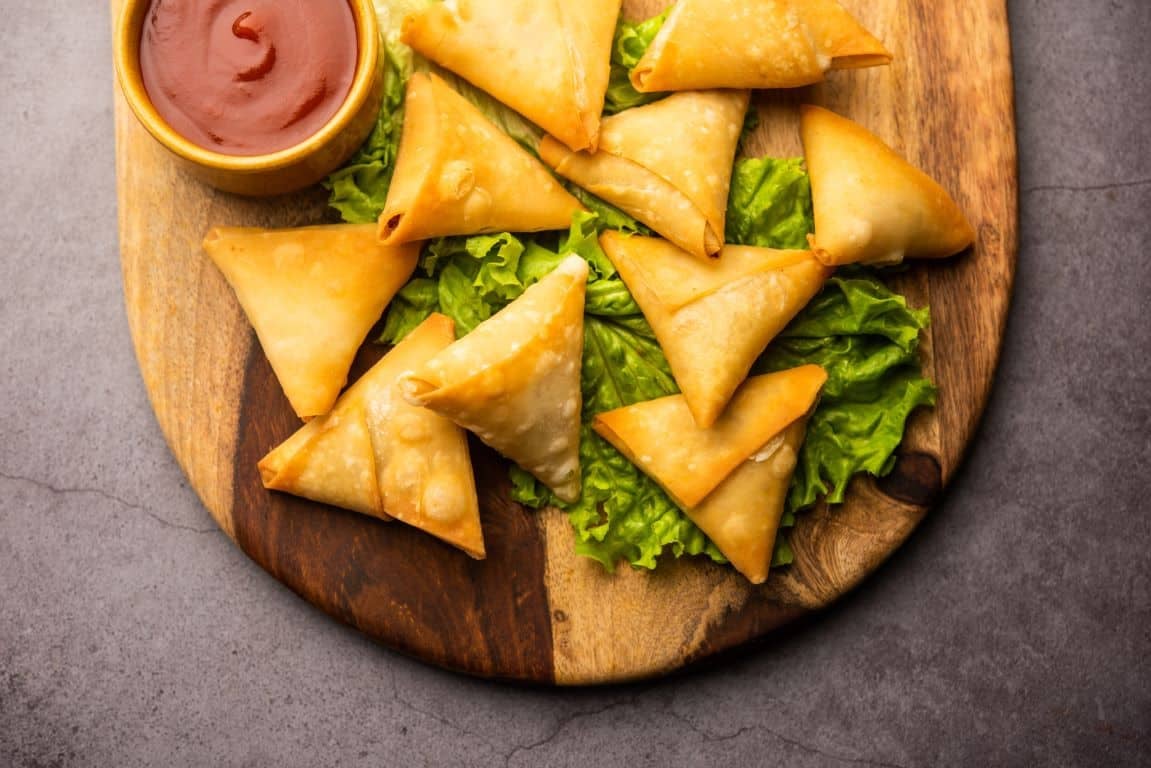
19. Tasty Samoosa
Samoosa, a delectable triangular snack, hails from the southern region of Iran, showcasing the country’s diverse culinary landscape. This deep-fried delight is crafted using lavash bread, skillfully folded and filled with an array of tantalizing ingredients, making it a cherished treat.
Known for its delightful kick, Samoosa often carries a spicy note, awakening the taste buds. The most beloved fillings include a zesty blend of ground beef and onion, packing a flavorful punch, or a hearty mix of potatoes and vegetables, creating a satisfying and balanced option for those seeking a vegetarian delight.
Samoosa’s crispy exterior and mouthwatering fillings exemplify the art of blending flavors and textures in Iranian cuisine. The combination of savory ingredients wrapped within the lavash bread creates a convenient and delicious snack, perfect for any time of the day. This southern specialty, with its intriguing blend of spices and diverse fillings, invites you to experience the rich tapestry of Iranian flavors, one delightful bite at a time.
Ingredients for Samosa
- Potatoes, boiled and diced
- Peas (fresh or frozen)
- Ground meat (optional, often lamb or chicken)
- Onions, finely chopped
- Garlic, minced
- Ginger, minced
- Green chilies, finely chopped (adjust to taste)
- Spices (commonly coriander, cumin, garam masala, turmeric, and chili powder)
- Fresh coriander leaves (cilantro), chopped
- Lemon juice
- Salt and pepper

20. Falafel
Falafel, a Middle Eastern staple, has made its mark as a popular street food in the southern regions of Iran, where it takes on its own unique flair. Crafted from chickpeas, this savory delight is often enjoyed as a sandwich, accompanied by a medley of fresh vegetables and the tantalizing twist of mango or pepper sauce.
Notably, cities like Bushehr, Ahwaz, and Bandar Abbas have become renowned for their exceptional Falafel offerings, showcasing the regional diversity and culinary expertise of Iran. These cities have become synonymous with this beloved dish, drawing locals and visitors alike to savor their delectable creations.
The fusion of Middle Eastern flavors with the Iranian touch creates a memorable culinary experience, inviting you to embark on a flavorful journey through the streets of southern Iran. Falafel, a beloved and satisfying treat, is a testament to the rich and diverse world of street food, bringing people together to enjoy the simple pleasure of a delicious, handheld delight.
Ingredients for Falafel
- Dried chickpeas (or canned chickpeas, drained and rinsed)
- Fresh parsley, chopped
- Fresh cilantro, chopped
- Onion, chopped
- Garlic cloves, minced
- Ground cumin
- Ground coriander
- Baking powder
- Salt and pepper
- Flour (all-purpose or chickpea flour, for binding)
- Vegetable oil (for frying)
Final Words
In conclusion, Iran’s array of snacks showcases the rich culinary heritage and diverse flavors of this enchanting country. From the sweet delicacies like Gaz and Sohan to savory bites like Kashk-e Bademjan and Faludeh, each snack offers a unique taste of Persian culture. These treats not only tantalize the taste buds but also tell a story of history, tradition, and the love for food that Iranians hold dear. Whether you’re a curious traveler or a culinary enthusiast, exploring Iran’s popular snacks is an adventure in itself.




